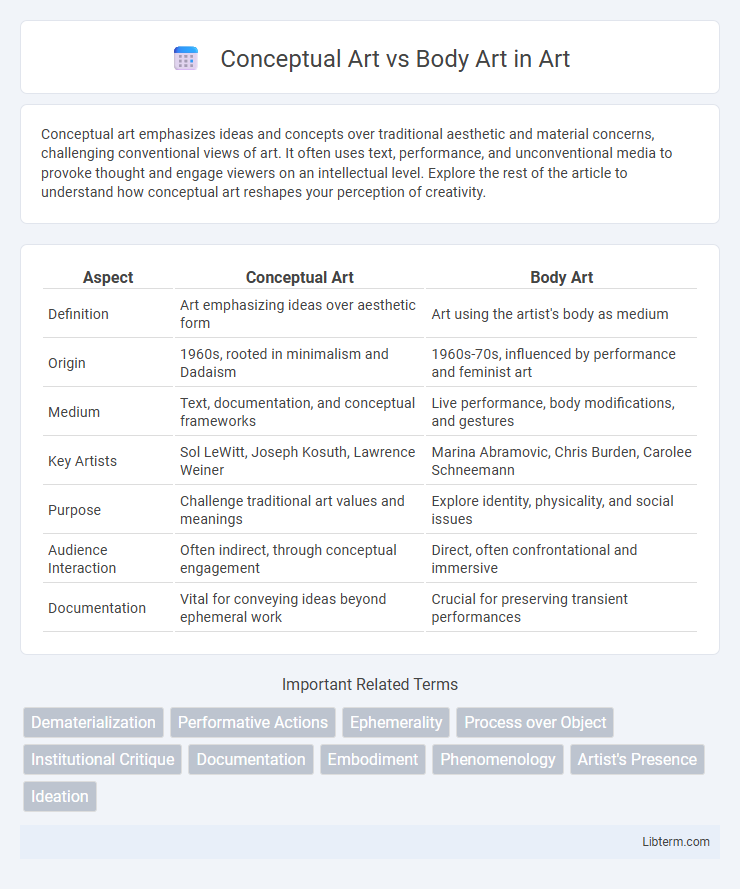Conceptual art emphasizes ideas and concepts over traditional aesthetic and material concerns, challenging conventional views of art. It often uses text, performance, and unconventional media to provoke thought and engage viewers on an intellectual level. Explore the rest of the article to understand how conceptual art reshapes your perception of creativity.
Table of Comparison
| Aspect | Conceptual Art | Body Art |
|---|---|---|
| Definition | Art emphasizing ideas over aesthetic form | Art using the artist's body as medium |
| Origin | 1960s, rooted in minimalism and Dadaism | 1960s-70s, influenced by performance and feminist art |
| Medium | Text, documentation, and conceptual frameworks | Live performance, body modifications, and gestures |
| Key Artists | Sol LeWitt, Joseph Kosuth, Lawrence Weiner | Marina Abramovic, Chris Burden, Carolee Schneemann |
| Purpose | Challenge traditional art values and meanings | Explore identity, physicality, and social issues |
| Audience Interaction | Often indirect, through conceptual engagement | Direct, often confrontational and immersive |
| Documentation | Vital for conveying ideas beyond ephemeral work | Crucial for preserving transient performances |
Introduction to Conceptual Art and Body Art
Conceptual Art emphasizes ideas and intellectual engagement over traditional aesthetic and material concerns, often using text, documentation, and performance to convey meaning. Body Art centers on the human body as both subject and medium, exploring identity, physicality, and vulnerability through live performance, tattooing, piercing, and other bodily interventions. Both movements challenge conventional art forms by prioritizing experience and concept over object-based artwork.
Historical Origins and Evolution
Conceptual Art emerged in the 1960s, emphasizing ideas over traditional aesthetic and material concerns, with pioneers like Sol LeWitt and Joseph Kosuth challenging conventional art forms by prioritizing intellectual engagement. Body Art developed simultaneously, rooted in performance and feminist movements, with artists such as Marina Abramovic and Carolee Schneemann using their own bodies as mediums to explore identity, politics, and physical presence. Both movements evolved as radical responses to institutional art, shifting focus from objects to experience and concept, fundamentally transforming contemporary art practices.
Defining Features of Conceptual Art
Conceptual Art prioritizes the idea or concept behind the work over traditional aesthetic and material concerns, emphasizing intellectual engagement rather than visual appeal. It often employs text, documentation, and ephemeral actions to challenge conventional art forms and question the nature of art itself. Unlike Body Art, which uses the human body as a direct medium of expression, Conceptual Art centers on abstract concepts and theoretical frameworks.
Defining Features of Body Art
Body Art emphasizes the use of the human body as the primary medium, often involving live performances, tattoos, piercings, and modifications to challenge conventional aesthetics and explore identity. It prioritizes personal experience, physical presence, and interaction between artist and audience, distinguishing itself from Conceptual Art's focus on intellectual ideas and symbolism. Key defining features include corporeal involvement, temporality, and the blurring of boundaries between art and life.
Influential Artists in Conceptual Art
Conceptual Art, pioneered by influential artists such as Sol LeWitt, Joseph Kosuth, and Lawrence Weiner, emphasizes ideas over traditional aesthetic and material concerns, redefining the role of art in society. These artists challenged conventional art forms through language, instruction, and minimalist presentations, shaping the movement's intellectual framework. In contrast, Body Art, exemplified by artists like Marina Abramovic and Chris Burden, centers on the physical presence and experiences of the artist's body, focusing on personal and performative expressions.
Pioneers of Body Art
Pioneers of Body Art such as Marina Abramovic, Chris Burden, and Carolee Schneemann transformed the human body into a dynamic canvas, emphasizing personal experience and physical presence. Their work challenged traditional artistic boundaries by using performance and endurance to explore identity, pain, and vulnerability. This contrasted with Conceptual Art pioneers like Sol LeWitt and Joseph Kosuth, who prioritized ideas and intellectual engagement over physical form.
Materials and Methods: Comparing Approaches
Conceptual Art prioritizes ideas over traditional materials, often utilizing text, documentation, or ephemeral objects to challenge perceptions of art's physical form. Body Art employs the living body as both medium and canvas, incorporating performance, tattooing, or body modifications to explore identity and corporeality. While Conceptual Art methods emphasize intellectual engagement through dematerialized forms, Body Art relies on direct sensory interaction and temporal presence of the human body.
Philosophical Underpinnings and Intentions
Conceptual Art emphasizes the primacy of ideas over aesthetic form, challenging traditional definitions of art by privileging intellectual engagement and questioning authorship and originality. Body Art, rooted in the direct use of the artist's body as a medium, explores themes of identity, vulnerability, and the physical limits of human experience, often aiming to provoke visceral responses. The philosophical core of Conceptual Art lies in dematerializing the artwork to highlight concepts, whereas Body Art foregrounds embodiment and materiality to investigate existential and sociopolitical conditions.
Audience Engagement and Interpretation
Conceptual Art engages the audience primarily through intellectual interaction, emphasizing ideas and provoking thought rather than visual aesthetics. Body Art involves direct physical presence, often using the artist's own body as a medium to create an intimate and immersive experience for viewers. Interpretation in Conceptual Art relies heavily on cognitive analysis and contextual understanding, while Body Art invites visceral, emotional responses linked to the physicality and temporality of the performance.
Lasting Impact on Contemporary Art Practices
Conceptual Art revolutionized contemporary art by prioritizing ideas over traditional aesthetics, influencing practices such as installation art, performance art, and new media, where meaning and message take precedence. Body Art, emphasizing the human body as both medium and subject, expanded artistic boundaries through visceral, often ephemeral works that challenge identity, politics, and viewer engagement. The lasting impact of both movements is evident in contemporary art's embrace of interdisciplinary approaches that merge intellectual inquiry with corporeal experience.
Conceptual Art Infographic

 libterm.com
libterm.com